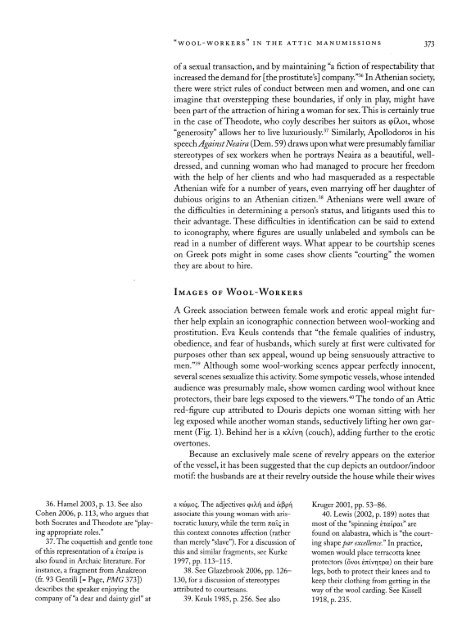Download - The American School of Classical Studies at Athens
Download - The American School of Classical Studies at Athens
Download - The American School of Classical Studies at Athens
Create successful ePaper yourself
Turn your PDF publications into a flip-book with our unique Google optimized e-Paper software.
36. Hamel 2003, p. 13. See also<br />
Cohen 2006, p. 113, who argues th<strong>at</strong><br />
both Socr<strong>at</strong>es and <strong>The</strong>odote are<br />
"play<br />
ing appropri<strong>at</strong>e<br />
roles."<br />
37. <strong>The</strong><br />
coquettish<br />
and<br />
gentle<br />
tone<br />
<strong>of</strong> this<br />
represent<strong>at</strong>ion<br />
<strong>of</strong> a exaipcc is<br />
also found in Archaic liter<strong>at</strong>ure. For<br />
instance, a fragment<br />
from Anakreon<br />
(fr. 93 Gentili [= Page, PMG 373])<br />
describes the speaker enjoying the<br />
company <strong>of</strong> "a dear and dainty girl" <strong>at</strong><br />
"WOOL-WORKERS" IN THE ATTIC MANUMISSIONS<br />
<strong>of</strong> a sexual transaction, and by maintaining "a fiction <strong>of</strong> respectability th<strong>at</strong><br />
increased the demand for [the prostitutes] company."36 In Athenian society,<br />
there were strict rules <strong>of</strong> conduct between men and women, and one can<br />
imagine th<strong>at</strong> overstepping these boundaries, if only in play, might have<br />
been part <strong>of</strong> the <strong>at</strong>traction <strong>of</strong> hiring a woman for sex. This is certainly true<br />
in the case <strong>of</strong> <strong>The</strong>odote, who coyly describes her suitors as (pitan, whose<br />
"generosity" allows her to live luxuriously.37 Similarly, Apollodoros<br />
in his<br />
speech AgainstNeaira (Dem. 59) draws upon wh<strong>at</strong> were presumably familiar<br />
stereotypes <strong>of</strong> sex workers when he portrays Neaira as a beautiful, well<br />
dressed, and cunning woman who had managed<br />
to<br />
procure her freedom<br />
with the<br />
help<br />
<strong>of</strong> her clients and who had<br />
masqueraded<br />
as a<br />
respectable<br />
Athenian wife for a number <strong>of</strong> years,<br />
even<br />
marrying<br />
<strong>of</strong>f her<br />
daughter<br />
<strong>of</strong><br />
dubious origins to an Athenian citizen.38 Athenians were well aware <strong>of</strong><br />
the difficulties in determining a person's st<strong>at</strong>us, and litigants used this to<br />
their advantage. <strong>The</strong>se difficulties in identific<strong>at</strong>ion can be said to extend<br />
to iconography, where figures are usually unlabeled and symbols can be<br />
read in a number <strong>of</strong> different ways. Wh<strong>at</strong> appear to be courtship scenes<br />
on Greek pots might in some cases show clients "courting" the women<br />
they<br />
are about to hire.<br />
Images <strong>of</strong> Wool-Workers<br />
A Greek associ<strong>at</strong>ion between female work and erotic appeal might fur<br />
ther help explain an iconographic connection between wool-working<br />
prostitution. Eva Keuls contends th<strong>at</strong> "the female qualities <strong>of</strong> industry,<br />
obedience, and fear <strong>of</strong> husbands, which surely<br />
<strong>at</strong> first were cultiv<strong>at</strong>ed for<br />
purposes other than sex appeal, wound up being sensuously<br />
<strong>at</strong>tractive to<br />
men."39<br />
Although<br />
some<br />
wool-working<br />
scenes<br />
appear perfectly innocent,<br />
several scenes sexualize this<br />
activity.<br />
Some<br />
sympotic vessels, whose intended<br />
audience was presumably male, show women carding wool without knee<br />
protectors, their bare legs exposed<br />
red-figure cup <strong>at</strong>tributed to Douris depicts<br />
373<br />
and<br />
to the viewers.40 <strong>The</strong> tondo <strong>of</strong> an Attic<br />
one woman<br />
sitting<br />
with her<br />
leg exposed while another woman stands, seductively lifting her own gar<br />
ment<br />
(Fig. 1). Behind her is a K/Uvn (couch), adding<br />
further to the erotic<br />
overtones.<br />
Because an exclusively male scene <strong>of</strong> revelry appears on the exterior<br />
<strong>of</strong> the vessel, it has been suggested th<strong>at</strong> the cup depicts an outdoor/indoor<br />
motif: the husbands are <strong>at</strong> their revelry outside the house while their wives<br />
a Kcojiot;. <strong>The</strong><br />
adjectives (pi^ri and appfi<br />
associ<strong>at</strong>e this<br />
young<br />
woman with aris<br />
tocr<strong>at</strong>ic luxury, while the term naiq in<br />
this context connotes affection (r<strong>at</strong>her<br />
than merely "slave").<br />
For a discussion <strong>of</strong><br />
this and similar see<br />
fragments,<br />
Kurke<br />
1997, pp. 113-115.<br />
38. See Glazebrook 2006, pp. 126<br />
130, for a discussion <strong>of</strong> stereotypes<br />
<strong>at</strong>tributed to courtesans.<br />
39. Keuls 1985, p. 256. See also<br />
Kruger 2001, pp. 53-86.<br />
40. Lewis (2002, p. 189) notes th<strong>at</strong><br />
most <strong>of</strong> the<br />
"spinning ETOctpoci"<br />
are<br />
found on alabastra, which is "the court<br />
ing shape par excellence.' In practice,<br />
women would place terracotta knee<br />
protectors (ovoi emvriTpa)<br />
on their bare<br />
legs, both to protect<br />
their knees and to<br />
keep their clothing from getting in the<br />
way <strong>of</strong> the wool carding. See Kissell<br />
1918, p. 235.
















